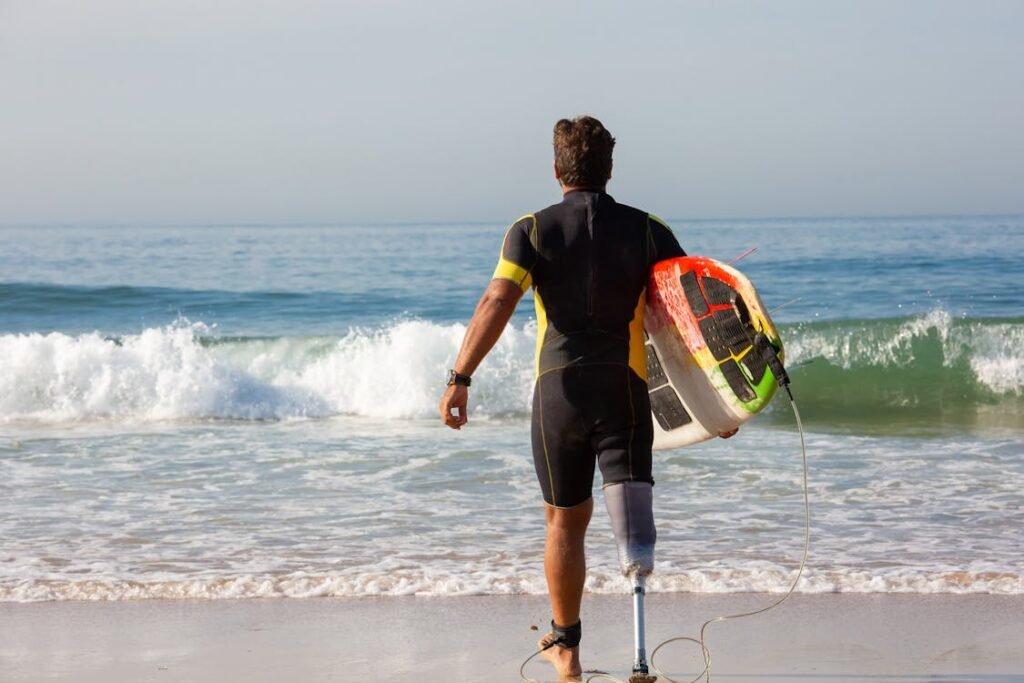In the world of sports, small differences can change everything. A tiny shift in balance. A second lost in reaction. A slight twist in movement. For athletes with prosthetics, these details are even more important. The way a prosthetic fits doesn’t just affect comfort — it shapes performance, endurance, and even the risk of injury.
Fitment is not just about making the prosthetic wearable. It’s about making it powerful. In competitive sports, where bodies are pushed to their limits, a poorly fitted prosthetic can become a barrier. But the right fit? It becomes a part of the athlete — helping them run faster, jump higher, and move with confidence.
At Robobionics, we’ve worked closely with athletes across India. We’ve learned that no two athletes move the same way. And no one should ever settle for a one-size-fits-all solution. Especially not in sports.
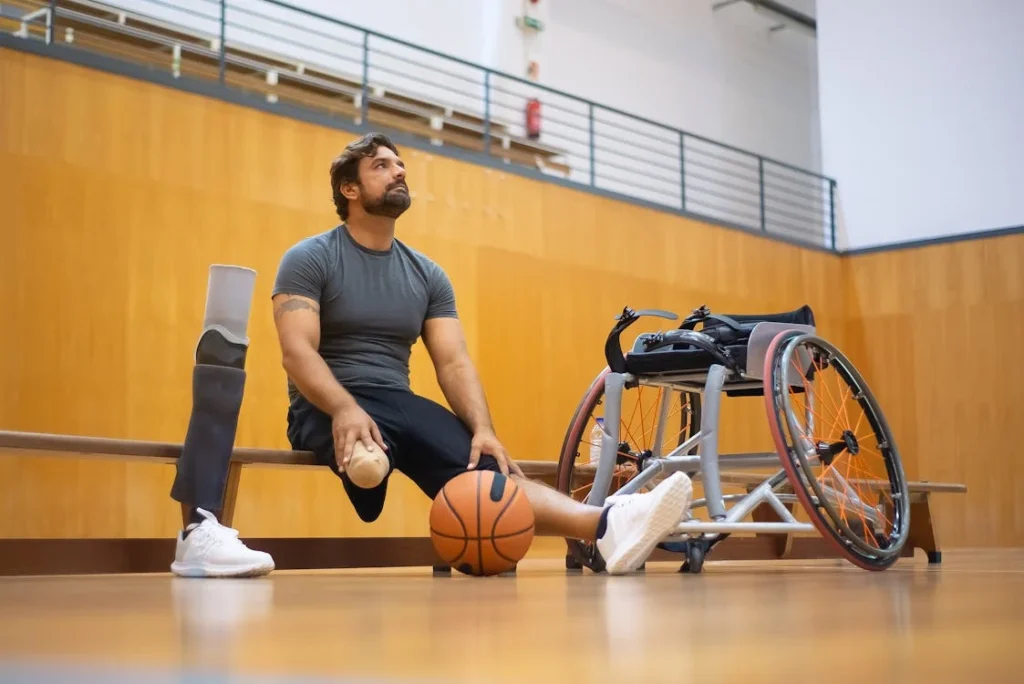
What Makes Sports Prosthetics Different from Everyday Use
More Than Just Movement — It’s Performance
Every prosthetic helps a person move. But a sports prosthetic does much more. It has to help the athlete move better. This means it must support speed, balance, power, and quick reactions — all under pressure.
Whether someone is sprinting, cycling, playing basketball, or lifting weights, their prosthetic must keep up with their body’s demands in real time.
This is what separates sports prosthetics from regular ones. In daily life, people walk, sit, stand, and carry out simple tasks. But in sports, bodies move faster, harder, and with more intensity. The prosthetic must match that energy — without slipping, without shaking, and without slowing the athlete down.
Even the smallest error in fitment — a few millimeters off in socket shape or limb alignment — can make the entire device feel unstable. That’s why we say precision is non-negotiable. There’s no room for guesswork when performance is on the line.
Forces Multiply in Motion
In sports, every step creates force. When a runner’s foot hits the ground, the force can be two to three times their body weight. That energy moves through the leg and into the prosthetic.
If the socket doesn’t fit perfectly, that force doesn’t spread evenly. It presses harder on some areas and barely touches others. This can lead to pain, fatigue, or even injury.
If the socket is slightly too tight, blood flow may be reduced. If it’s loose, the limb can move inside the socket and cause skin damage or blisters. None of these are small problems — especially for an athlete trying to focus on winning, not worrying about pain.
That’s why, at Robobionics, we spend time studying how the limb behaves during real-time motion. We look at how muscles shift, how weight is distributed, and how movement patterns affect the socket. This allows us to design fitment that doesn’t just feel right in a static pose — but moves right during high-impact actions.
Different Sports Need Different Designs
Not all sports require the same movements. A swimmer’s prosthetic is shaped differently from a runner’s. A javelin thrower needs explosive power.
A footballer needs fast pivots and lateral motion. This is why sport-specific prosthetics are built with unique goals in mind — and the fit must reflect those goals too.
For example, a prosthetic foot made for running has a springy shape that stores energy and pushes back with each step. If it’s not aligned correctly to the limb, the energy will be wasted. Worse, it can throw off the user’s balance. The result is slower performance and higher risk of injury.
Fitment plays a huge role in making sure that design meets demand. It makes sure the energy the athlete puts in doesn’t get lost in the device — but is returned exactly where it’s needed.

How Poor Fitment Affects Athletic Ability
The Hidden Burden of Discomfort
When a prosthetic isn’t fitted well, the first thing the athlete feels is discomfort. But discomfort isn’t just a side effect — it’s a major performance blocker.
If a runner feels even a small pinch inside the socket with every step, they’ll naturally adjust their stride to avoid the pain. Over time, this throws off their form, reduces speed, and can cause injury on the opposite side of the body.
This kind of hidden burden creates distraction. The mind, instead of staying focused on the game, starts focusing on the pain. Instead of pushing harder, the athlete starts pulling back. And that gap — that hesitation — can be the difference between winning and losing.
We’ve seen athletes with world-class strength and training struggle because their device simply didn’t feel right. And we’ve seen those same athletes shine after just one adjustment that changed everything.
Muscle Fatigue and Energy Waste
In sports, energy is currency. Every bit of it matters. When a prosthetic doesn’t fit well, the user spends extra energy just trying to stabilize. Muscles work harder to keep balance. Small shifts in alignment force the body to compensate in unnatural ways.
Over time, this leads to faster fatigue. The athlete may start strong, but they can’t sustain the effort. Their muscles give out sooner. Their focus drops. And the risk of injury rises sharply.
Good fitment means the body and the prosthetic move together, in harmony. It means the athlete can put in effort without losing energy to imbalance or resistance. And it means they can go longer, harder, and safer — all because the fit was right from the start.
Injuries That Don’t Always Show Right Away
Some effects of poor fitment don’t appear on day one. They build slowly. Tiny strains in soft tissue. Pressure points that lead to swelling. Muscle imbalances that wear down joints. These problems often go unnoticed until they stop the athlete entirely.
Precision in prosthetic fitment is what prevents these issues. It protects the athlete’s health not just during the game, but for years ahead. We believe that performance and protection must go together. One without the other is incomplete.
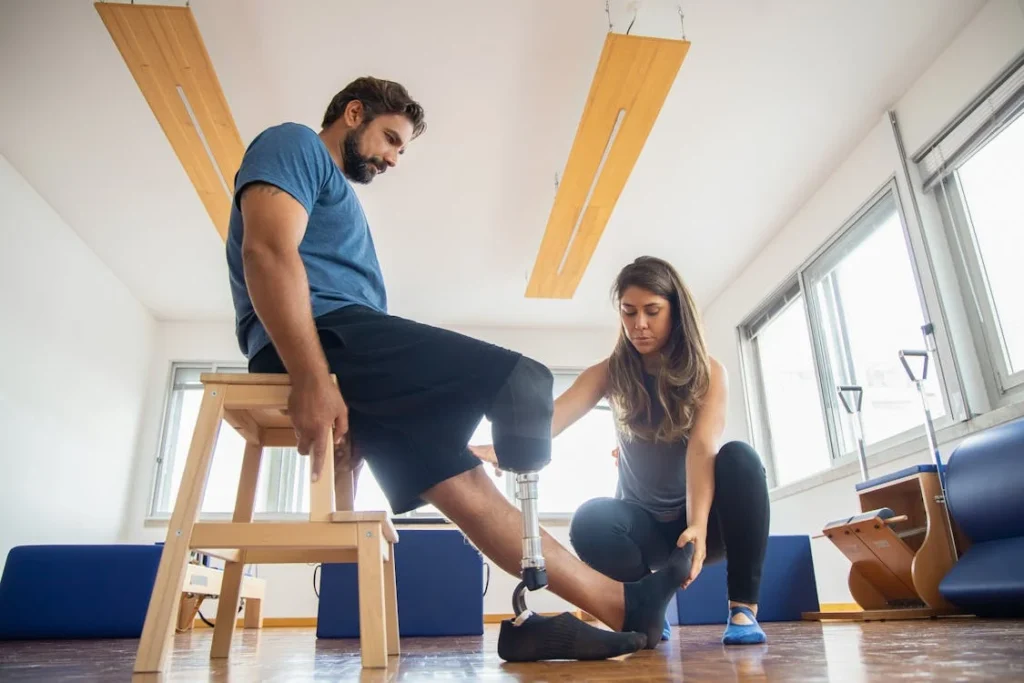
The Fitment Process for Sports Prosthetics: A Closer Look
It Starts with Understanding the Athlete
No two athletes are the same. Even if they play the same sport, their bodies, their movements, and their goals are all unique. That’s why the fitment process doesn’t begin with measurements.
It begins with listening. Understanding how the athlete trains, how their body moves, and what challenges they’ve faced with previous devices.
We ask the right questions: What kind of terrain do you play on? Are you experiencing discomfort when you push off or land? Do you need more speed, more control, or more stability?
These answers help shape the direction of the fitment. They guide not only the physical measurements but the choices we make in materials, socket shape, flexibility, and alignment. It’s not about giving the best prosthetic in general — it’s about giving the right prosthetic for that athlete.
The Role of Digital Tools in Precision Fitment
Once we understand the athlete’s needs, we move to digital tools — and this is where things get exciting.
Using 3D scanning, we capture the exact shape and contour of the residual limb. This scan gives us a full, real-time map of the limb. Every bump, curve, and muscle shift is recorded in precise detail. It takes just seconds, and it removes any guesswork from the process.
Next, we apply AI technology to analyze that scan. This step is especially powerful because the AI doesn’t just look at the surface. It compares the scan to hundreds of previous cases. It recognizes patterns in pressure zones, movement types, and risk areas.
It helps us understand what kind of fit will work best — not just in theory, but based on real-world results.
This digital guidance leads to a socket that feels natural and responsive. One that moves with the body, instead of fighting against it.
Test Fittings and Real-Time Feedback
After we create the first socket, we don’t move straight to the final prosthetic. We go through test fitting — and this is where athlete feedback becomes everything.
We ask the athlete to walk, jog, or even mimic their game-day movements while wearing the test socket. We observe posture, alignment, muscle response, and facial expressions. We listen carefully. Even a small hesitation in a movement can signal something is off.
The feedback loop is quick. Adjustments are made, sometimes digitally and sometimes by hand. The goal is to reach a point where the athlete forgets about the device — because that’s when the fit is right.
When it no longer feels like a piece of equipment, but instead feels like part of the body, we know we’ve succeeded.
Aligning for Power, Not Just Comfort
Comfort is essential — but in sports, it’s not enough. The prosthetic must be aligned for performance.
This means we study the athlete’s center of gravity. We check how the prosthetic lines up with their spine, hips, and other limb. We measure how much force is transferred from the ground through the device. If the alignment is even slightly off, it can throw the entire body out of rhythm.
A well-aligned sports prosthetic helps the athlete feel faster, more stable, and more confident in every move. It reduces wasted energy and increases power output. And most importantly, it supports the body in a way that prevents overuse and injury.
This is the part of fitment that’s often overlooked — but it’s the part that makes the biggest difference in high-level performance.
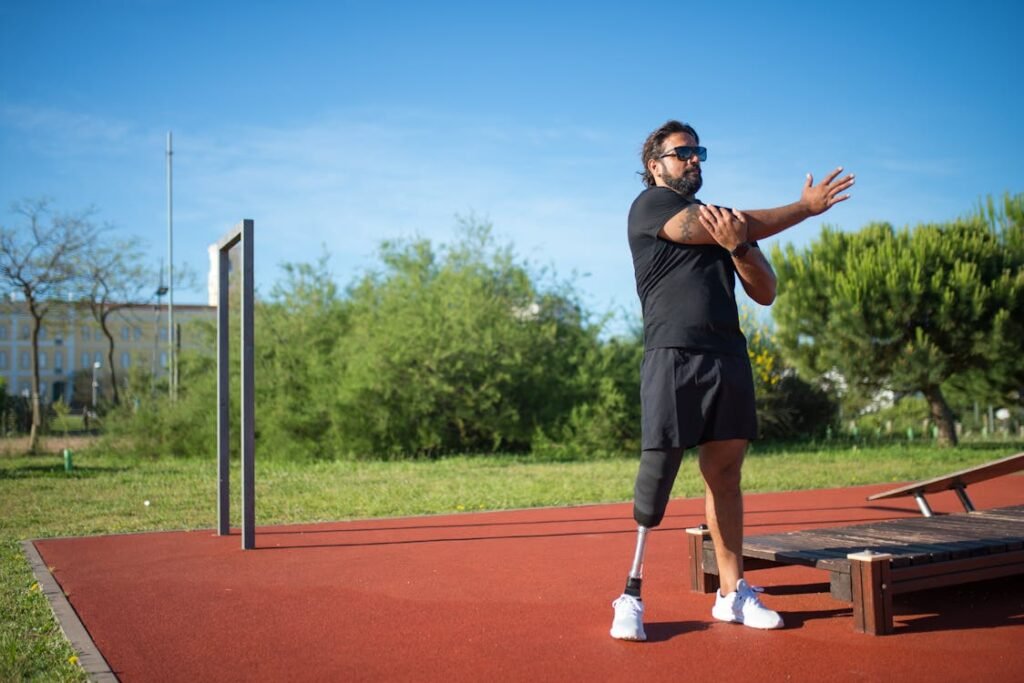
How Fitment Builds Athlete Confidence and Mental Strength
Trusting the Body Again
Athletes need to trust their body — completely. They need to know that when they leap, sprint, or turn, their prosthetic won’t hold them back or cause pain. This trust is not automatic. It’s built over time, through repeat use, and through the experience of a secure fit.
When a prosthetic fits well, the athlete feels grounded. Every movement feels clean and controlled. There are no surprises — no sudden slips or shocks. That sense of reliability is what allows the athlete to push harder, reach further, and go faster.
They stop thinking about their prosthetic. They start thinking about their goals.
Confidence in Competition
Sport is as much mental as it is physical. Confidence is often the edge that separates the winner from the runner-up. A poor-fitting prosthetic can slowly chip away at that confidence. It creates doubt — in movements, in training, and in performance under pressure.
But a perfectly fitted prosthetic can do the opposite. It becomes a source of confidence. A well-balanced stride. A solid stance. A strong grip. These small things send a signal to the brain: You are ready.
That mental state — calm, focused, and fearless — is where great performance lives.
Emotional Recovery Through Physical Precision
For athletes who’ve lost a limb, returning to their sport is a powerful form of healing. It helps them reconnect with who they are, and what they’re capable of. But that emotional recovery depends heavily on the body’s ability to cooperate.
If the prosthetic hurts or feels unstable, the emotional strain returns. It becomes a reminder of limitation. But if the fit is smooth, and the device performs well, it becomes a reminder of progress.
We’ve seen athletes light up after their first perfect sprint. Not because of speed. But because of what that moment meant. Fitment made that moment possible.
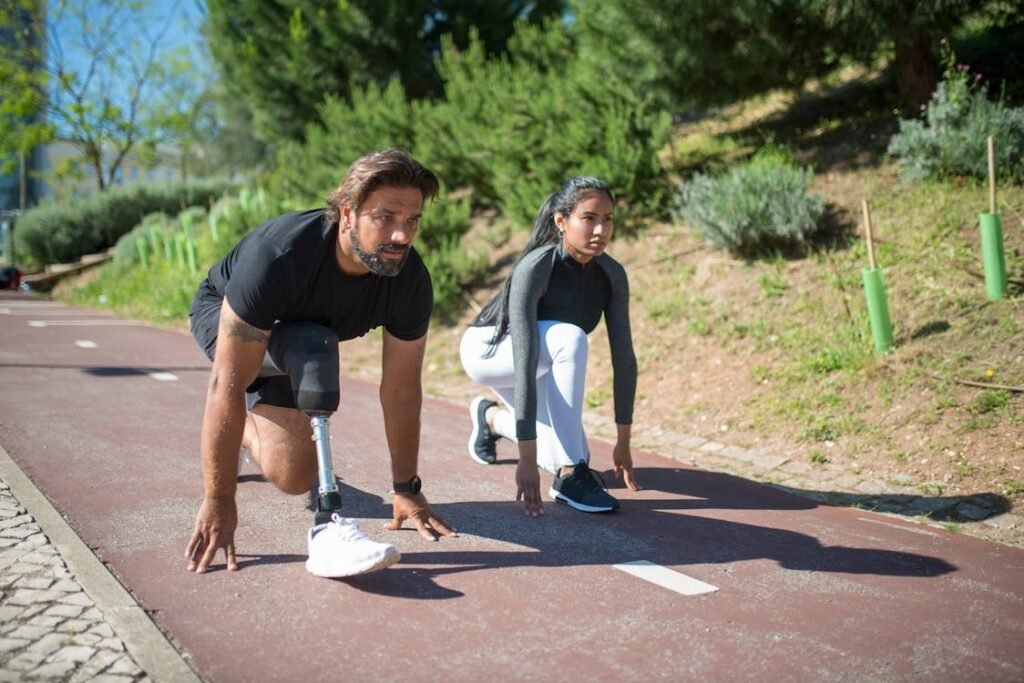
Retraining the Athlete: Why Precision Fitment Shapes Rehab Success
When Movement Patterns Change
After limb loss, the body naturally changes how it moves. Muscles adapt. Balance shifts. The brain starts building new patterns to keep the person upright and moving. This process is even more complex for athletes, whose movements are faster, more forceful, and often more repetitive than the average person.
Once a sports prosthetic is fitted, it’s not just about putting it on and walking out the door. The body has to learn how to move with the new device. This means retraining balance, posture, speed, timing, and control. It’s a demanding process — one that tests both body and mind.
But here’s where it gets critical: if the fitment isn’t right, the retraining doesn’t work. The body begins learning how to move around the prosthetic’s discomfort instead of through it.
Movements become unnatural. Some muscles overwork while others weaken. Over time, this leads to poor performance and, worse, avoidable injury.
Good rehabilitation can only begin with good fitment. Otherwise, the foundation is already cracked.
Gamified and Functional Rehab Only Works with a Good Fit
Many modern sports rehabilitation programs use game-like tasks to help athletes retrain specific movements. At Robobionics, for example, we support gamified rehab strategies that simulate real-world motions — like catching, sprinting, or jumping. These tools help rewire the brain and body connection, rebuilding athletic flow and rhythm.
But for these programs to work, the prosthetic must feel like a part of the athlete’s body. If the socket moves slightly with every step, the brain will hesitate.
If the grip doesn’t hold during resistance training, the athlete will limit their effort. Rehab tools can’t fix these issues. Only the fitment can.
When the prosthetic fits precisely, the rehab process becomes smoother, faster, and more effective. The athlete can focus on building strength and coordination instead of managing pain or slipping devices. Each repetition becomes a true step forward — not a workaround.
Mental Fatigue and the Risk of Plateaus
Precision fitment also plays a hidden role in managing mental fatigue during rehabilitation. When every movement feels wrong or causes friction, the athlete gets tired faster. Not just physically, but mentally. They lose motivation. The exercises feel harder. Progress slows.
This often leads to plateaus — periods where no improvement is seen, even with effort. These moments can be deeply frustrating for athletes who are used to pushing through challenges. A poorly fitting prosthetic turns what should be progress into struggle.
But when the fitment is exact, everything changes. Movements feel cleaner. Energy lasts longer. Rehab sessions become moments of growth instead of pain management. The mind stays clearer. The will stays stronger.
Fitment, then, becomes a key tool in avoiding burnout and pushing through those difficult middle stages of retraining.
Creating Long-Term Athletic Form
When an athlete first begins using a prosthetic, they’re not just learning how to move again — they’re creating a new normal. Whatever movements they repeat during training will eventually become automatic. This is known as motor memory, and once it sets in, it’s hard to change.
If the fitment isn’t right, that motor memory will be based on poor form. And poor form leads to inefficiency, instability, and strain. It also takes twice as long to fix later on.
That’s why we always say: don’t rush the fitment. Take the time to get it right at the beginning. Because that’s what shapes every movement that follows. A perfectly fitted sports prosthetic allows rehab to build strong, clean, repeatable form — the kind that supports performance for years, not just weeks.
This is one of the biggest differences between prosthetics for everyday life and prosthetics for sport. In sports, the details of movement matter so much more.
Every wrong angle is a missed opportunity. Every millimeter of imbalance can echo through the entire body. And that’s why the fit must be nothing less than exact.
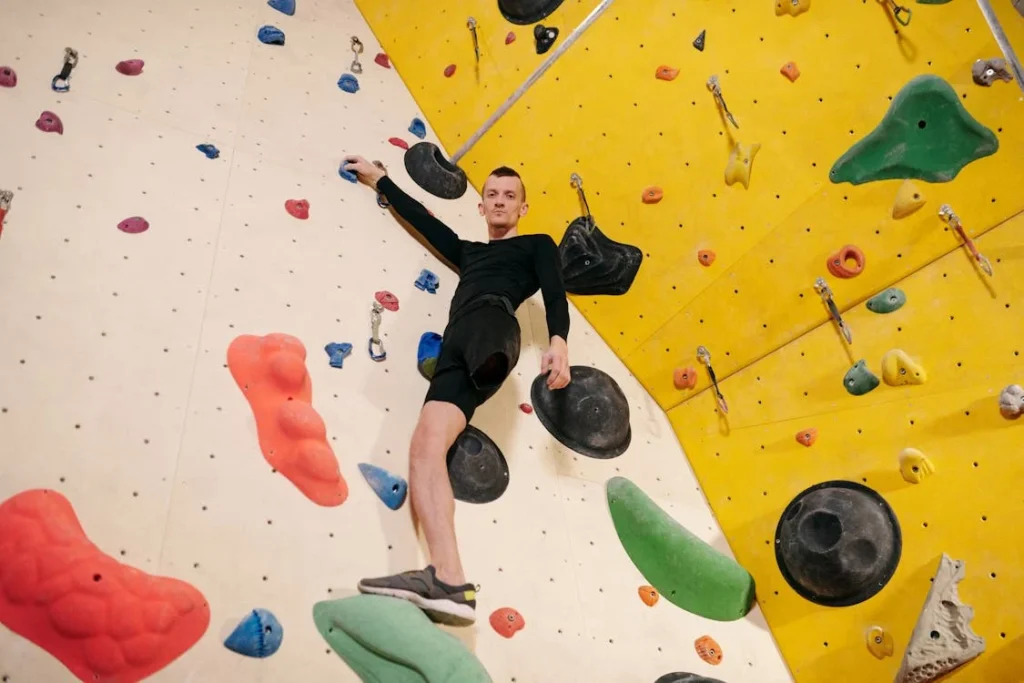
Adaptability Across Environments: Why Fitment Must Be Ready for Anything
Sports Don’t Happen in Perfect Conditions
Most athletes don’t compete inside a lab. They train and perform in real-world settings — hot weather, rainy fields, uneven ground, slippery courts, dusty tracks, and sometimes even high altitudes. The body must adjust. The mind must stay sharp. And the prosthetic? It has to keep up.
That’s why sports prosthetics are not just designed for power and speed. They also need to be built for resilience. They must perform under pressure, in conditions that aren’t always ideal.
But no matter how advanced the materials are — carbon fiber, titanium, silicone — the performance still depends on how well the prosthetic fits the body.
If the socket doesn’t hold firmly during a downhill run, if it shifts during a sudden sprint on wet grass, or if sweat causes internal movement, then performance suffers. Worse, the risk of a fall or injury skyrockets.
A perfectly fitted prosthetic adapts alongside the athlete. It doesn’t buckle under pressure. It doesn’t become a burden in extreme environments. It becomes a constant, no matter what the external conditions bring.
Weather and Sweat Management Depend on Fit
One of the most overlooked challenges in sports prosthetics is sweat. High temperatures and intense exertion mean the body heats up fast. The residual limb, now enclosed in a socket, gets even hotter.
Moisture builds up. And if the socket isn’t fitted properly, that moisture turns into slippage — sometimes even creating suction issues that make the prosthetic feel unstable.
Good fitment takes this into account. At Robobionics, we design sockets that not only hug the limb precisely but also allow for breathability and moisture escape.
This helps athletes stay focused and comfortable even when the heat is intense or the match runs long.
Precision fitment means there are no unintended gaps, no loose zones, and no sudden shifts when the limb starts sweating. It ensures the device remains as consistent on minute one as it does on minute sixty.
Terrain Changes Demand Seamless Transitions
An athlete might begin training on a smooth surface and end on an uneven trail. They might shift from indoor gyms to outdoor competitions. These transitions are part of sport — and the prosthetic needs to support them without missing a beat.
Fitment plays a crucial role here. A loose-fitting socket might feel manageable on flat ground, but the moment the terrain changes — with dips, inclines, or soft patches — that looseness becomes dangerous.
The limb may jostle, the grip may weaken, and reflex movements become harder to control.
Precise fitment allows for stability across surfaces. It creates a sense of rootedness, even when the ground beneath is unpredictable. This is especially important in sports like trail running, long jump, or field events where every landing has to be secure.
We’ve worked with athletes who train across city streets, village fields, forest trails, and beach sand. Their lives aren’t limited to one kind of environment. Neither should their prosthetics be.
Fitment That Supports Dynamic Adjustments
In some high-performance cases, athletes use adjustable components in their prosthetic systems — like shock absorbers, joint dampers, or carbon footplates with tunable stiffness.
These parts are great for enhancing performance in specific sports, but they only work well when the foundation socket is stable and secure.
If the base fit isn’t precise, those dynamic features won’t function properly. Adjusting tension won’t help if the limb moves inside the socket. The spring-back won’t fire correctly if alignment is off by even a degree.
And most dangerously, added features may misfire during impact or strain.
Precision fitment ensures that all other performance systems can work as intended. It’s the anchor that allows smart features to do their job, instead of being wasted or — worse — causing harm.
This is where technology meets anatomy. And it only works when the fitment process is taken seriously.
Conclusion
In sports, there are no shortcuts. Every move counts. Every second matters. And for athletes using prosthetics, the journey begins with something that’s often overlooked — fitment. It’s not just about comfort. It’s about control, safety, and confidence. It shapes how the body moves, how the mind performs, and how far the athlete can go.
At Robobionics, we’ve seen how a perfectly fitted sports prosthetic transforms everything. It turns hesitation into action. It prevents injury before it starts. And it gives athletes the freedom to focus on the game, not the gear.
Whether on the track, field, court, or trail, precision fitment is the foundation. It adapts to pressure, responds to terrain, and supports peak performance in every condition. That’s why, in the world of sports prosthetics, precision isn’t optional. It’s non-negotiable.



